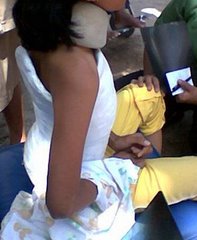Juvenile Rheumatoid Arthritis: Follow-up
Author: C Egla Rabinovich, MD, MPH, Associate Professor and Co-Division Chief, Department of Pediatrics, Division of Pediatric Rheumatology, Duke University Medical Center
Contributor Information and Disclosures
Updated: Apr 7, 2010
Follow-up
Further Inpatient Care
Further inpatient care is required for persisting fevers of unknown origin or when children with known juvenile idiopathic arthritis (JIA) have severe exacerbation of disease. Admit for evaluation any child who loses the ability to walk for unknown reasons. Development of pericarditis in children with systemic juvenile idiopathic arthritis is usually an indication for admission.
Further Outpatient Care
Patients may have a gradually responsive disease (particularly those with pauciarticular juvenile idiopathic arthritis).
A small number of patients with pauciarticular juvenile idiopathic arthritis develop aggressive arthritis confined to a single joint; such patients may require more intensive medical treatment and physical therapy.
Some patients with polyarticular juvenile idiopathic arthritis demonstrate rapid response to treatment; however, most have prolonged courses, requiring frequent adjustments in medical and nonmedical therapy. Some have sufficient problems with activities of daily living, and they may benefit from courses of outpatient (and sometimes inpatient) rehabilitation.
Inpatient & Outpatient Medications
See Medication.
Transfer
Consider outpatient evaluation in a pediatric rheumatology center for all patients with known and suspected disease. Inpatient care for individuals with intercurrent illnesses may best be carried out at local hospitals; complications from juvenile idiopathic arthritis usually indicate transfer to a hospital with a pediatric rheumatology center.
Treatment of macrophage activation syndrome (MAS) is a medical emergency and should be done by physicians familiar with this complication.
Deterrence/Prevention
No prevention methods are known. The best means of deterrence is compliance with recommended treatment. As many as one half of patients may not comply with every detail of recommended treatment. Persisting noncompliance is a problem that increases risk of morbidity. Parents of such patients often admit noncompliance only to the child's primary care physician, rather than to a pediatric subspecialty team. The continued monitoring of compliance by the primary care physician, together with continuing communication between the pediatric subspecialist and primary physician, is an important part of the treatment of children with juvenile idiopathic arthritis and any chronic illness.
Complications
The following complications may occur:
• Systemic-onset juvenile idiopathic arthritis
o Pericarditis (patients often presenting with orthopnea and responsive to intravenous corticosteroid treatment)
o Hemolytic anemia
o Disseminated intravascular coagulopathy (DIC), often present at a low level of activity: The levels of D-dimer and fibrinogen may be elevated; their return to reference range levels is observed with successful treatment.
o MAS
This is a rare, but important, complication, in which numbers of all 3 bloodlines become rapidly decreased. Hypofibrinogenemia, thrombocytopenia, and elevated aspartate aminotransferase levels are hallmarks.
Hypotension, CNS disease, and marked hepatosplenomegaly may be noted as complications of a release of massive amounts of cytokines.
Bone marrow aspiration may reveal histiocytic consumption of bone marrow precursors, which confirms the diagnosis and excludes malignancy. One does not need to see the histiocytic consumption for diagnosis of MAS.
MAS often responds to cyclosporin A, and some case reports have detailed response to anakinra.
o Endarteritis resulting in circulatory compromise of the digits with threatened autoamputation
This complication is even more rare than MAS.
Central administration of prostaglandin E1 may be of potential benefit, similar to its use for patients with scleroderma and endarteritis.
• Pauciarticular juvenile idiopathic arthritis
o Knee flexion contractures: This complication requires splinting at night, in addition to medical treatment, to restore range of motion, allow recovery of muscle strength, and avoid subluxation of the joint. Intra-articular corticosteroid injection should be strongly considered.
o Uveitis
Often asymptomatic, patients are typically young girls who have positive levels of antinuclear antibody (ANA).
In such patients, evaluation using a slit-lamp examination by a pediatric ophthalmologist every 4 months can detect early disease.
Treatment with topical corticosteroid medication and with mydriatic agents (to prevent closed-angle glaucoma) often can prevent progression of disease to development of calcium deposition in the lens (band keratopathy) and adhesions of the iris to the lens (posterior synechiae), in which an irregular pupillary margin develops.
Such complications may herald a chronic active disease, in which vision is threatened; immunosuppressive agents, such as methotrexate or cyclosporin, may help to control chronic uveitis. Infliximab can be effective in some patients who are resistant to immunosuppressive agents.
o Leg length discrepancy (can result from neovascularization of growth plates of an affected knee)
The problem may not be detected in patients with a knee flexion contracture until the contracture is corrected.
Treatment consists of a shoe lift on the nonaffected side.
• Polyarticular juvenile idiopathic arthritis
o Skeletal abnormalities - Increased size of epiphyses, accelerated bone age, narrowed joint spaces, swan-neck and/or boutonniere deformities, and joint subluxation
o Cervical spine involvement
Difficulty flexing the spine may create a problem for intubation prior to surgery; inform anesthesiologists of the patient's diagnosis. Screening cervical spine radiography (in both flexion and extension) may help screen for potential difficulties during induction of anesthesia.
High-level subluxation is a potential complication.
Prognosis
Some studies suggest that many children with juvenile idiopathic arthritis can lead productive lives. However, other studies suggest many patients, particularly those with polyarticular disease, may have problems with active disease throughout adulthood, with sustained remission attained in a minority of patients. Early hip or wrist involvement, symmetric disease (even in pauciarticular patients), presence of rheumatoid factor, and prolonged active disease have been associated with poor long-term outcomes.
Children with systemic disease tend to have either complete responsiveness to medical therapy or development of a polyarticular course that tends to be refractive to medical treatment, with disease persisting into adulthood.
Most children with pauciarticular disease demonstrate eventual permanent remission; a small number progress to persisting polyarticular disease.
Patient Education
Educating the patient, family, and school personnel (eg, classroom teachers, physical education teachers, nurses) about juvenile idiopathic arthritis and its presentation, treatment, and potential effects is continually necessary. Members of the pediatric rheumatology team in pediatric rheumatology clinics are the best educators about juvenile idiopathic arthritis. Another important source of information is the American Juvenile Arthritis Organization, a council of the Arthritis Foundation.
For excellent patient education resources, visit eMedicine's Arthritis Center. Also, see eMedicine's patient education articles Juvenile Rheumatoid Arthritis and Understanding Rheumatoid Arthritis Medications.
Miscellaneous
Medicolegal Pitfalls
The major medicolegal pitfall lies in diagnosing juvenile idiopathic arthritis (JIA) when another problem exists (eg, infection, malignancy, orthopedic problem). Whenever possible, referral to a pediatric rheumatologist can help address this issue. Careful attention to presenting history and initial physical examination findings can lower the likelihood of such a pitfall. However, the chance of such a pitfall can never be eliminated completely.
At the time of diagnosis, inform parents and/or caregivers of the possible need to revise the diagnosis of juvenile idiopathic arthritis should new symptoms, physical findings, or unusual laboratory results develop.
Special Concerns
Chronic illness imposes burdens on families, who may vary in their abilities to cope. Social workers can help provide assessment and assist families in finding resources (including counseling). Remind parents and/or caregivers to bring all questions to the pediatric rheumatology team, who can often help. Any unusual symptom may signal a new complication of disease or adverse effect of medication. In the current health care environment, managed care can result in initial denial of services (eg, physical therapy), resulting in delays in treatment with subsequent morbidity. Advocacy by the primary care physician and pediatric rheumatologist can help point out the need for such services.
Acknowledgments
The authors and editors of eMedicine gratefully acknowledge Michael L Miller, MD, to the original writing and development of this article.
Subscribe to:
Post Comments (Atom)








No comments:
Post a Comment